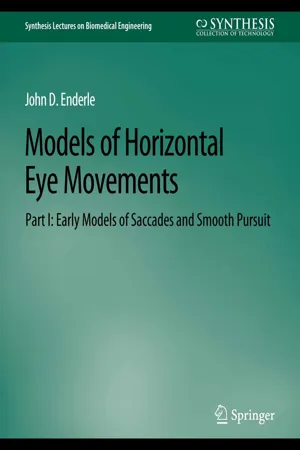
Models of Horizontal Eye Movements, Part I
Early Models of Saccades and Smooth Pursuit
John Enderle
- English
- PDF
- Disponible sur iOS et Android
Models of Horizontal Eye Movements, Part I
Early Models of Saccades and Smooth Pursuit
John Enderle
À propos de ce livre
There are five different types of eye movements: saccades, smooth pursuit, vestibular ocular eye movements, optokinetic eye movements, and vergence eye movements. The purpose of this book is focused primarily on mathematical models of the horizontal saccadic eye movement system and the smooth pursuit system, rather than on how visual information is processed. A saccade is a fast eye movement used to acquire a target by placing the image of the target on the fovea. Smooth pursuit is a slow eye movement used to track a target as it moves by keeping the target on the fovea. The vestibular ocular movement is used to keep the eyes on a target during brief head movements. The optokinetic eye movement is a combination of saccadic and slow eye movements that keeps a full-field image stable on the retina during sustained head rotation. Each of these movements is a conjugate eye movement, that is, movements of both eyes together driven by a common neural source. A vergence movement is a non-conjugate eye movement allowing the eyes to track targets as they come closer or farther away. In this book, early models of saccades and smooth pursuit are presented. The smooth pursuit system allows tracking of a slow moving target to maintain its position on the fovea. Models of the smooth pursuit have been developed using systems control theory, all involving a negative feedback control system that includes a time delay, controller and plant in the forward loop, with unity feedback. The oculomotor plant and saccade generator are the basic elements of the saccadic system. The oculomotor plant consists of three muscle pairs and the eyeball. A number of oculomotor plant models are described here beginning with the Westheimer model published in 1954, and up through our 1995 model involving a 4$^{th}$ order oculomotor plant model. The work presented here is not an exhaustive coverage of the field, but focused on the interests of the author. In Part II, a state-of-art model of the saccade system is presented, including a neural network that controls the system. Table of Contents: Introduction / Smooth Pursuit Models / Early Models of the Horizontal Saccadic Eye Movement System / Velocity and Acceleration Estimation / 1995 Linear Homeomorphic Saccadic Eye Movement Model
Foire aux questions
Informations
Table des matières
- Cover
- Copyright Page
- Title Page
- Contents
- Acknowledgments
- Introduction
- Smooth Pursuit Models
- Early Models of the Horizontal Saccadic Eye Movement System
- Velocity and Acceleration Estimation
- 1995 Linear Homeomorphic Saccadic Eye Movement Model
- Bibliography
- Author's Biography